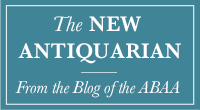The ABAA New York International Antiquarian Book Fair returns to the iconic Park Avenue Armory in New York City from April 3-6, 2025, celebrating its 65th Edition. Below are some highlights from among the many rare items the more-than 200 exhibitors will be bringing to New York from all over the world. (Tickets are available at this link...)
FIVE DOLLAR BILL POSE--RARE IN THIS FULL-PLATE SIZE
One Of The Most Sought-After And Iconic Poses Of Lincoln
IN A SIZE THAT COMMANDS ATTENTION
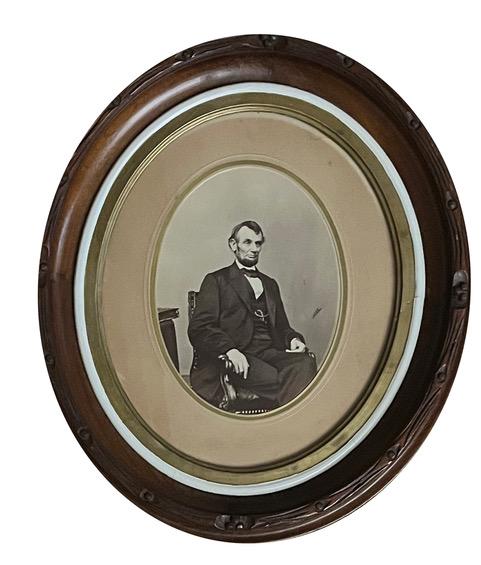
(Lincoln Photograph) Berger, Anthony
Oval Sepia Albumen Photograph, on original card mount [O-92]. [Washington, DC: Mathew Brady Gallery, 9 February 1864]. Original oval decorative wooden frame. 8”x6” (sight); 16-3.8” x 14-1/2” (frame). A fine and rare full-plate original print of the famous “$5bill” pose (only lately retired during currency redesign), taken by Anthony Berger at Mathew Brady’s Washington gallery on 9 Feb. 1864. Robert Todd Lincoln called this “the most satisfactory likeness”of his father. It is one of several poses Berger took that day including the beautiful portrait of Lincoln and his son Tad viewing a photo album; that same album is quite visible, sitting on a table at Lincoln’s right. Lincoln’s watch fob is unusually distinct, as are his cheek bones and famous mole.I nterestingly, Lincoln’s barber had parted his hair on the right side, whereas it was usually seen parted on his left side. Also quite distinct is the famous “Brady Chair” of carved oak made by Bembe & Kimbel and one of 262 chairs commissioned for the US House of Representatives in 1857. Purportedly Brady received this chair as a gift from Lincoln and no less than five US presidents sat in it for Brady portraits. [In 2015 it brought $449,000 atauction.] In a handsome, 19th century wood shadow-box frame w/ inner gilt and painted white fillet border that seems to be made for this frame. Excellent; superb clarity and deep tonality, by direct contact off the glass negative; a few small marring of the albumen sits well away from the Lincoln image and hardly detracts; edges of mount clipped.
Offered by Abraham Lincoln Book Shop, booth A30.
Maugham, W. Somerset.
Of Human Bondage.
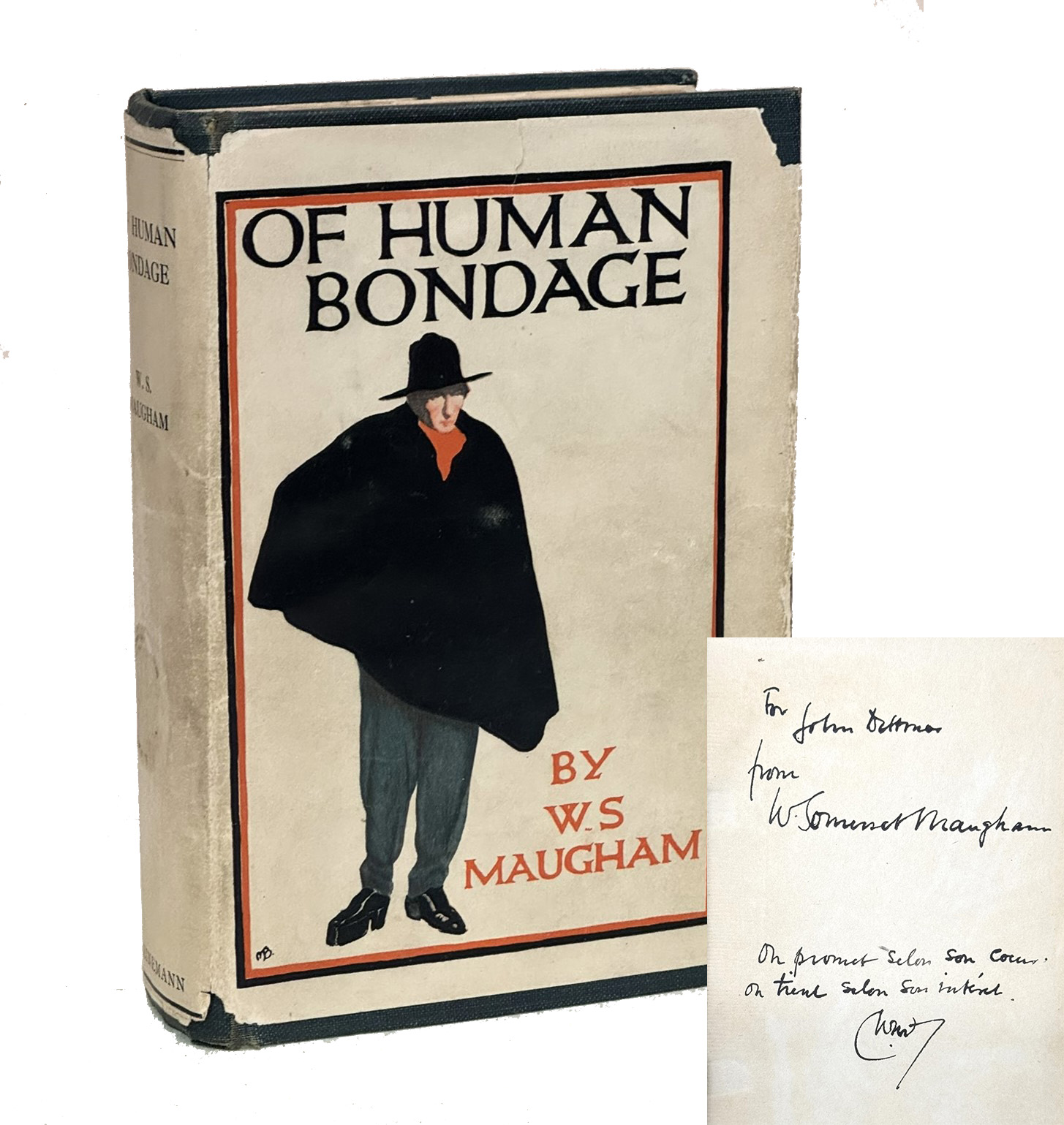
London: William Heinemann, 1922. First English edition, first issue (this edition was published on August 13th, 1922, just one day after the first American edition). Presentation copy, signed and inscribed by Maugham. With an additional couple of lines in French, signed with his initials WSM, “On prompt selon son coeur / on tient selonson interet.” One of 5,000 copies. Publisher’s petrol blue cloth, with author’s symbol in gilt to front board, publisher’s windmill device in blind to rear board, and gold lettering to front board and spine; in its original white first state dust jacket, with a drawing of Philip Carey wearing a black cape, red cravat, and black artist’s homburg hat with a widebrim, signed by “M.B.,” and lettered in black and red. Very good or better with some rubbing to the extremities, a few minor spots to fore-edge; a few small chips and minor loss to spine ends and upper front panel, price sticker residue to spine. Overall, a remarkable copy of this canonical work of 20th century English literature in the extremely scarce dust jacket. Housed in a red custom half morocco slipcase with a folding chemise.
Of Human Bondageis a bildungsroman featuring the protagonist Philip Carey, a club-footed orphan who is raised by his religious aunt and uncle. From a young age, Carey yearns for adventure and moves to Paris to pursue a career in art. Subsequently, he moves to London to study medicine, where he meets the androgynous Mildred, with whom he begins a torturous love affair that will forever alter the course of his life. A strongly autobiographical novel (Maugham’s formative source of shame was a stammer rather than a club foot), Of Human Bondage is considered Maugham's masterpiece. The book was adapted into three films in 1934, 1946, and1964. The films starred Leslie Howard and Bette Davis, Paul Henreid and Eleanor Parker, and Laurence Harvey and Kim Novak as Philip and Mildred, respectively.
Famously, the first dust jacket for the first English edition was rejected, likely because the club foot on the front panel drawing of Carey was on the wrong foot, and 5,000 corrected jackets were produced. According to Stott, 440 copies of the book were delivered to the binder before the corrected jackets arrived, so it is possible that these copies had the uncorrected jacket on them. The French quote in Maugham’s inscription is attributed to the 17th century French moralist François de La Rochefoucauld and translates into English as “We promise according to our heart / we keep according to our interest.” Maugham discovered Rochefoucauld in his youth, and his influence can be seen in many of Maugham’s novels and plays.
Offered by B&B Rare Books, booth B9.
Miller, Henry
Tropic of Cancer [with] Tropic of Capricorn
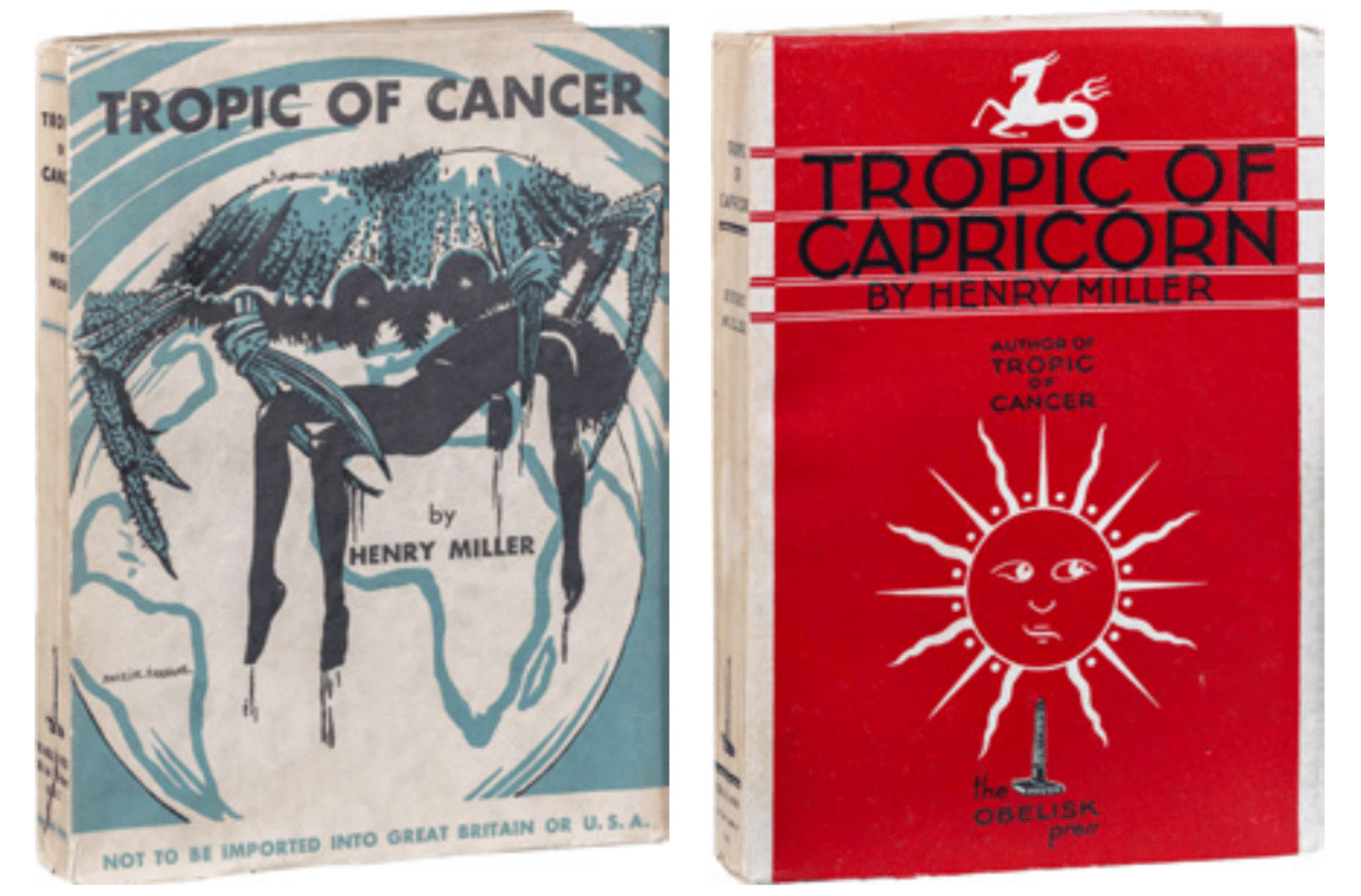
Paris: The Obelisk Press, 1934 [and] 1939. 2 vols. Minor rubbing and split the spine of Tropic of Cancer, else two fine first editions, in the originl wrappers, without restoration. Both with custom boxes.
Tropic of Cancer is primarily set in Bohemian Paris around 1930, where the locals could stay up on New Year’s Eve and watch their hopes drop. It’s half autobiography and half exaggerated fantasy, but it’s mainly lighthearted, and its promiscuous carnal zeal is from a more sincere time. Tropic of Capricorn is a first edition (in English despite the Paris imprint), and likely first issue, though the price has been scratched out on front flap and spine, a part of the ‘0’ is legible on the front flap, so it was not stamped over and there is no ‘175.00’ printed on the rear wrapper. Despite this, we will pretend it’s a 2nd issue and include it with Tropic of Cancer for free. Tropic of Cancer was banned in, and difficult to buy in, or even bring into the U. S. until 1961, and the preoccupations of the ’30s, ‘40s, and ‘50s didn’t help its ready availability, migrating to my question about moral (as opposed to political) suppression. If some novel depraves and corrupts, why then is the person chosen to be the censor always the person who is the most depraved and corrupted?
Offered by Biblioctopus, booth C7.
A Fine Beatrix Potter Two Page Autograph Letter Illustrated with Three Charming Ink Sketches
POTTER, Beatrix, artist. Autograph Letter signed to Dulcie. Sawrey [England] near Ambleside: 16 November 1923.
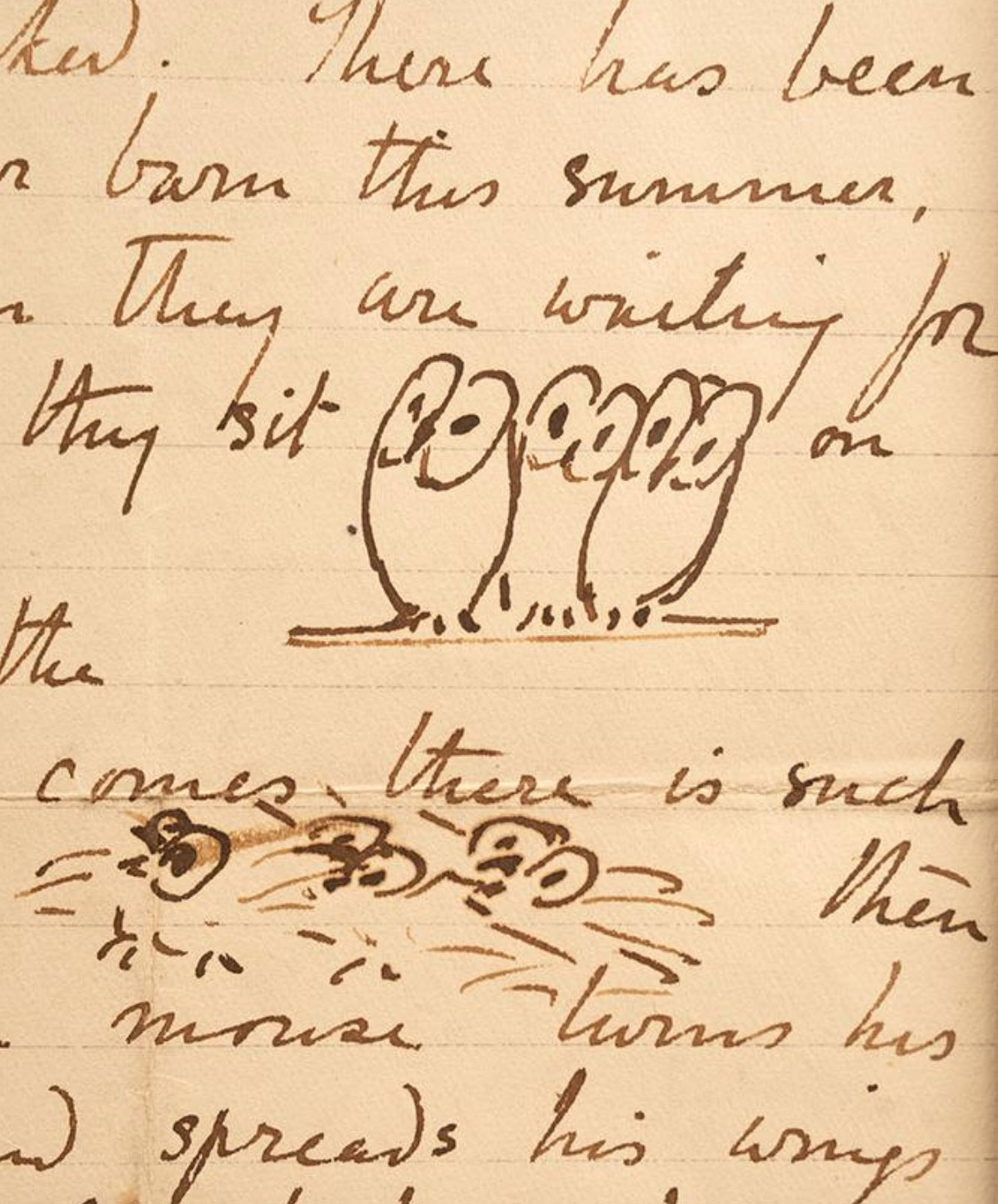
A fine and charming two-page illustrated autograph letter dated “Nov. 16. 23” to “My dear Dulcie…” Matted, framed and glazed. Written on recto and verso. The first page of the letter on the verso of the frame (a facsimile of this first page is framed on the left hand side, so that both pages can be read at the same time).
Two pages, quarto. Page size (9 x 6 ½ inches; 229 x 165 mm.). Frame size (21 1/4 x 27 1/2 inches; 540 x 699 mm.). The second page of the letter contains three ink sketches: (1). Three owlets sitting “on a board”…; (2). Three owlets “such a scramble & a squawking”…; (3). One of the owlets spreading “his wings & tail like an umbrella…”
A wonderful illustrated letter, discussing many of her animals by name, mentioning their particular habits, etc. A fine and charming letter. The recipient, Dulcie, was a close friend, there are nine letters from Potter to Dulcie featured in Judy Taylor's book, Letters to Children, pp. 180-190.
Dulcie was a young friend who shared Potter's interest in domesticating animals. "Dulcie is one the most intriguing of 'Beatrix's children', probably because there is no clue at all to her identity. There is a hint in the letter of 29 July 1924 that she lived in London. They corresponded over the years and developed a close friendship often comparing notes on their pet friends. She and Beatrix obviously enjoyed exchanging anecdotes about their pets and Beatrix's letters to Dulcie are particularly warm." (Taylor, p. 181).
Offered by David Brass Rare Books, booth D2.
Merritt, A. (Abraham)
Seven Footprints to Satan (Hannes Bok's Copy in Scarce Original Dust-Jacket)

New York: Boni and Liveright, 1928. 1st Edition. Hardcover. Near Fine / Very Good. 310pp.
Sharp First Edition, with "B&L" monogram oncopyright page and no statement ofprinting. Interestingly, the Boni & Liveright edition has "Seven" on the front board, spine and half-title page but "7" on the title page. Merritt's classic mash-up of crime novel and supernatural horror story though the true nature of the criminal mastermind is obscure. Bound in original brown cloth with titles in red on front board, with staircase motif, and on spine. Square, tight and clean throughout with barely a hint of toning and no foxing. Some mild wear to spine ends, edges and tips. Very attractive unclipped original publisher's dust-jacket, ($2.00 on top of front flap), has light damp-stains to the flaps and along the fore-edge of the rear panel. Expert restoration to remove oldtape, re-coloring of rubbed areasand chips replaced in facsimile, mostly to the heel and crown, and almost certainly by a professional paper conservator.
A fresh and bright example. From the library of iconic Science Fiction, Fantasy and Horror artist, (and author), Hannes Bok, with his rubber-stamped ownership stamp on the front end-paper. First Editions of this title are uncommon in the marketplace, particularly in nice condition. There are a plethora of reprints, some very well done in colorful jackets that are uncommon in their own right. A bit of luster has been expertly put back onthis jacket, and any copies in the original dust-jacket are almost impossible to find. A very pretty collectable copy and a great association.
Offered by Brenner's Collectible Books, booth D24.
MESSISBUGO, Christoforo. Banchetti. Ferrara: De Buglhat & Hucher, 1549.
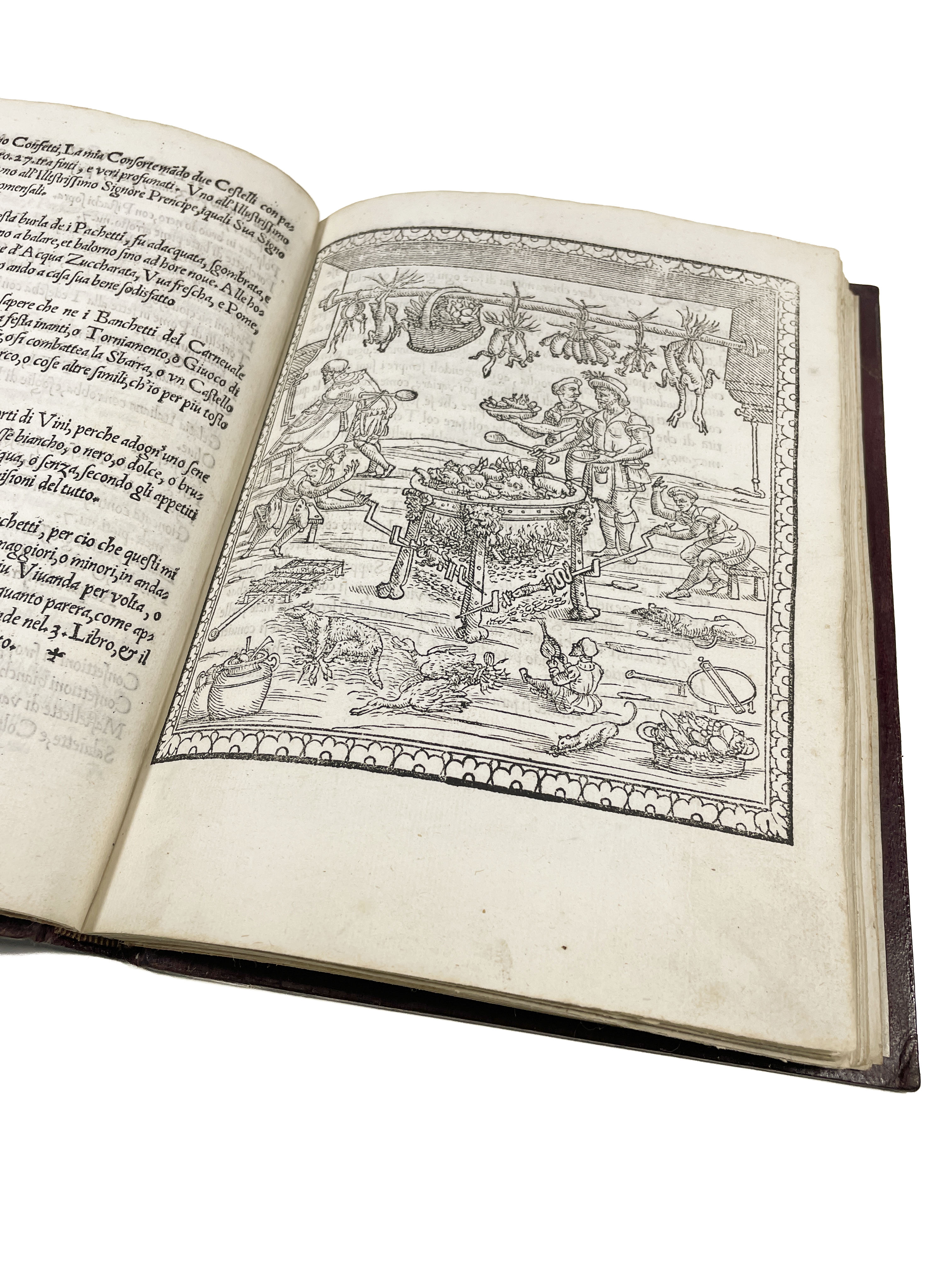
4to. Three full-page woodcut illustrations and two full-page printer’s devices in the text. [8], 22, [2], 71, [1 - blank], 7, [1 - blank] ll. Late 19th-century plumb morocco, all edges of boards with single gilt fillet, spine simply gilt in five compartments.
The extremely important and rare FIRST EDITION of Cristoforo Messisbugo’s groundbreaking contribution to gastronomy during the European Renaissance. The first section of the work reconstructs the feasts organized by Messisbugo for his patron, Hippolyte d’Este, Cardinal of Ferrara, son of Lucrezia Borgia and Alphonse d’Este. A large woodcut depicts one of these meals, with several dogs feasting on leftovers in the foreground, while another woodcut shows the interior of the kitchens during the preparation of the banquet. Both images are famous in gastronomic literature. The second section is a collection of roughly 345 recipes which document the Italian cuisine of the time. Included are various kinds of pies (pizze); pasta; sauces; charcuterie; fritters; broths; fish dishes; torte; and cheeses. There are also vegetarian recipes designed for holy days. In addition to recipes, the author discusses logistical considerations, such as kitchen utensils and supplies.
Messisbugo was one of the first great cookbook authors of the modern era. His Banchetti…published posthumously in 1549, not only offers...recipes organized by subject but also detailed descriptions of spectacular meals served at the ducal court of the Este family in Ferrara between 1529 and 1548. It is intended as a practical guide for rulers who hope to imitate such banquets, and even details the equipment required down to every last plate and the entire kitchen and wait staff, a veritable army of servants. It thus offers the first fairly complete picture of what was involved in banquet organization in the early sixteenth century. – Ken Albala in Alice Arndt’s Culinary biographies.
In very good condition and preserved in a clamshell box of half calf over marbled boards.
Offered by Ben Kinmont, Bookseller, booth C5.
Emil PIRCHAN (1884-1957)
Two orginal marbled papers by Emil Pirchan, who was a student of Otto Wagner, worked as an architect, (set-)designer, painter in close contact to members of the „Secession“ and „Wiener Werkstätte.“
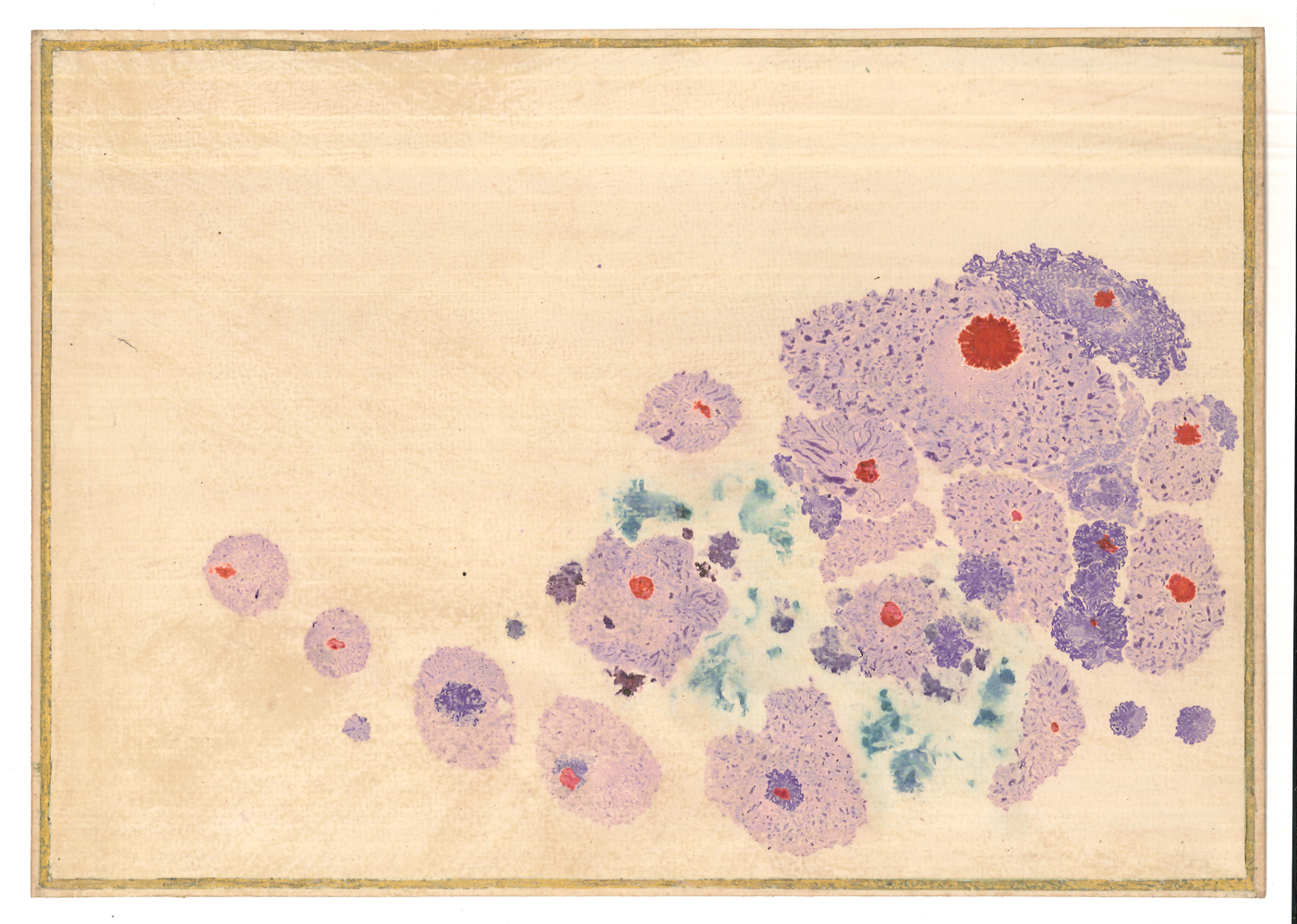
Artworks by him were difficult to find until recently and are rare.
This set of beautiful watercolors made in a marbling technique on paper, until recently owned by his family and held back.
Offered by Burgverlag Rare Books, booth A31.
[Jane Austen] Helen Sewell. Collection of Six Original Signed Drawings for the Limited Editions Club Edition of "Pride and Prejudice"
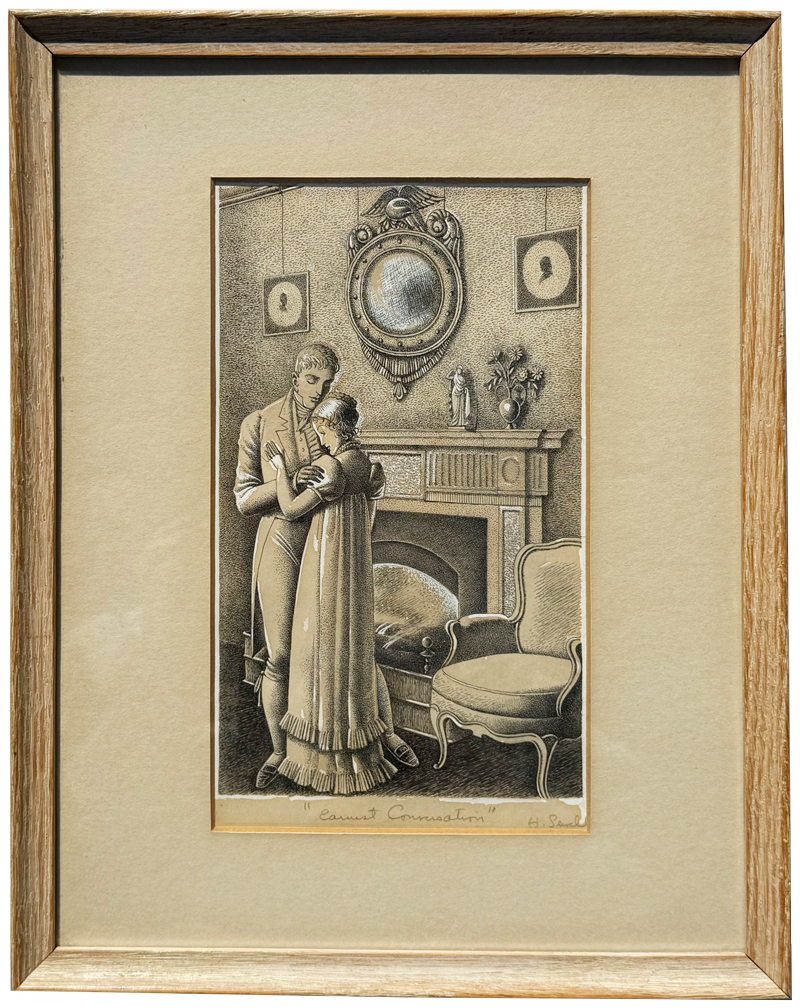
New Jersey? ca. 1940. Collection of six original pen drawings signed and captioned in pencil, all uniformly framed (drawings: 20x11.5cm; frames: 29.5x23cm.). Light yellowing of stock else Fine, not examined out of frames. The collection includes:
a. The probability of a rainy season
b. Such very superior dancing
c. Wickham's affection for Lydia
d. Mr. Bingley is come
e. Earnest conversation
f. Improvements on the harp
An exceptional collection of original illustrations by the Caldecott Honor-winning artist Helen Sewell (1896-1957), who gained recognition eight years earlier for providing the illustrations to Laura Ingalls Wilder's "Little House in the Big Woods" (1932) as well as the seven ensuing Little House books.
Orphaned at a young age, Sewell was raised by her aunt and uncle in Brooklyn, New York, and at the age of twelve was the youngest pupil at the Pratt Institute where she studied under the avant-garde painter and sculptor Alexander Archipenko. In part thanks to the fame from illustrating Wilder's popular series, Sewell was chosen to illustrate the Limited Editions Club editions of Jane Austen's novels "Pride and Prejudice" (1940) and "Sense and Sensibility" (1957), as well as the Poems of Emily Dickinson (1952).
"It is not idle whimsy to say that Helen Sewell is Jane Austen in new incarnation...To give them a proper emotional spirit, she made these drawings in the style of the steel engravings which were used as illustrations for the books of Jane Austen's time...Every one of the fifty drawings made by Sewell is a devilish imitation of a nineteenth century steel engraving. In every one of them, there are literally thousands of pen lines...to make these pictures she had to have the wit of the devil and the charm of an archbishop" (from "The Heritage Club Sandglass," no. 3m, accompanying the Heritage Club reprint of "Pride and Prejudice"). See also the Britannica article on Sewell's life.
Offered by Capitol Hill Books, booth C10.
Collection of 50 plates and projects of atomizers & crystal bottles.
"Cristalleries de Nancy", 1920s-1930s
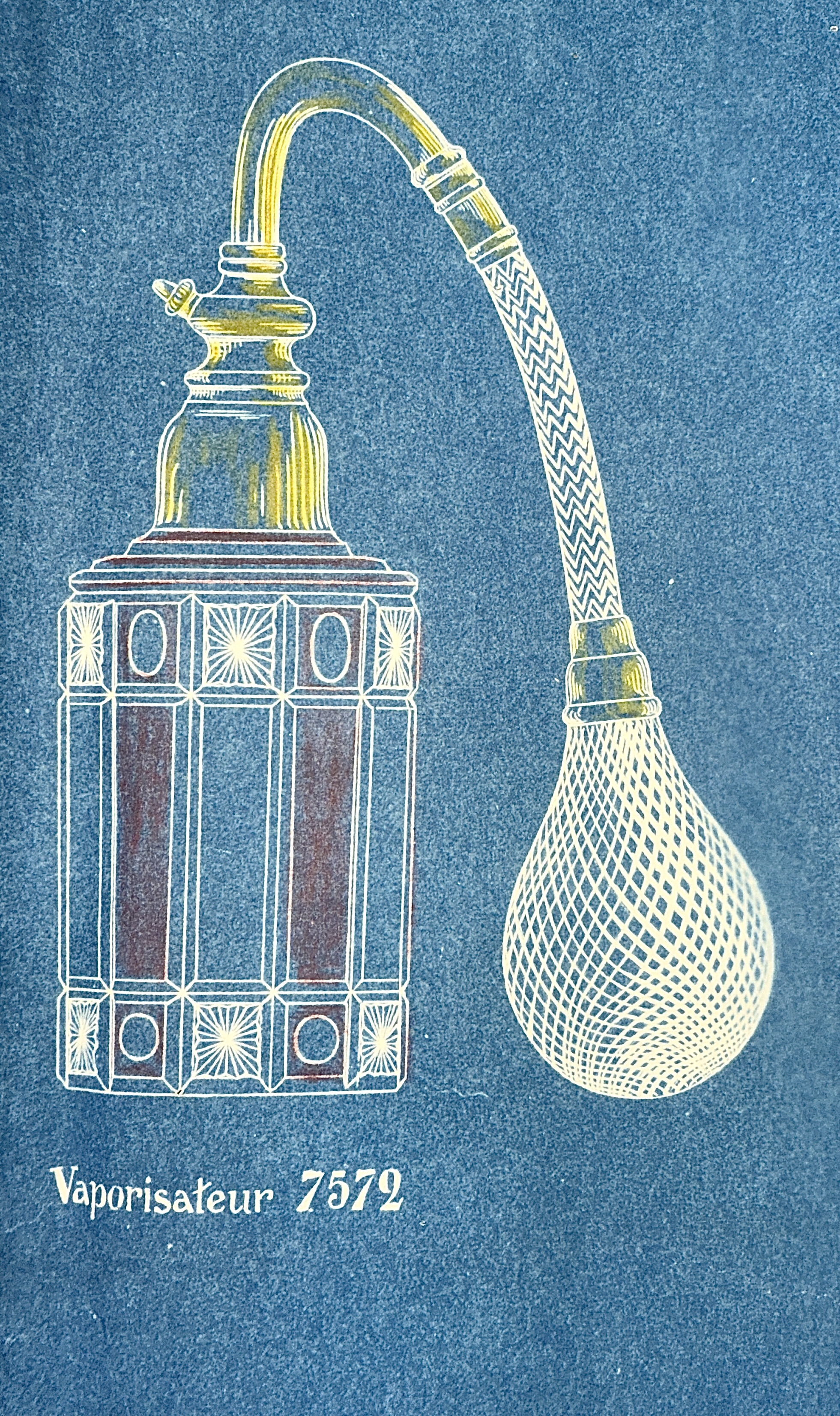
A superb collection bringing together 50 plates and projects documenting the production of the Cristalleries de Nancy / Nancy crystal works in the field of perfumery. The manufactory played a significant role in the art of bottle making from the 1920s to the early 1930s, with models whose aesthetics closely resemble those of Baccarat (cf. Gérard Caussaint, Nancy, La cristallerie oubliée, Loraf Editions, 2020, p. 199).
At that time, the Nancy Crystal Works supplied many of the major perfume brands, the most famous undoubtedly being Guerlain (the crystal works was notably one of the suppliers of the “quadrilobed stopper” or “heart stopper” bottles for Guerlain). Other notable names include Moehr, D’Orvil, Drialys, Philippe Gendron, Moiret, and Gloria Campbell.
The Nancy Crystal Works aimed to provide bottle models—those seen in our plans—that could be purchased by perfumers of the time. They also fulfilled specific orders from clients seeking new designs, for which projects and estimates were created.
One such client was Saks of New York (Fifth Avenue). Our collection includes three blueprints of bottles specially made for them, as well as a soapbox model bearing the “Saks Fifth Avenue” logo, an order dated August 31, 1928.
"With the 20th century and Art Nouveau, perfumery became increasingly concerned with the beauty of the bottle. In 1907, François Coty, who believed that a perfume bottle should be a true work of art reflecting the quality of its contents, partnered with glassmaker René Lalique for the commercialization of the 'Ambre Antique' perfume. After the First World War came the Roaring Twenties, marked by a race toward modernity, the pursuit of novelty and exoticism. Art Deco succeeded Art Nouveau. Paul Poiret, having already freed women from the corset and established perfume as an essential part of feminine attire, created 'Rosine' (named after his eldest daughter), designing his own bottles. (…) In 1925, at the International Exhibition of Decorative Arts, the greatest French perfumers were represented: Coty and his stunning Lalique bottles, the perfumes of Rosine, L.T Piver, and especially Guerlain, which presented its legendary 'Shalimar' in a Baccarat-designed bottle." (Les enfants du parfum, online)
Our collection mainly contains atomizers and perfume bottles. Additionally, it includes a few pomade boxes and toiletry sets, which completed the luxury offerings of the great houses of the time.
Offered by Cabinet Chaptal, booth A27.
Explicit Crime Scene Photographs of the Lizzie Borden Crime Scene

In August 1892, Andrew Borden and his second wife Emma were murdered in their home in Fall River, Massachusetts. There were several possible suspects; daughter Lizzie Borden was tried for the crime. She was eventually found not guilty and spent the rest of her life in Fall River. This was one of the most sensational murders of the late nineteenth century and has led to numerous theories, books, plays, and films. Twelve 14”x 10” photographs (including two duplicates) of the crime scene are in these two slipcases. The pictures were purchased at auction from Swann Galleries in 1992 and have been in a private collection since then. The images depict the murdered parents and the home of the Borden family. The collection is in good condition, with fading, and the cardboard mounts are worn and chipped.
Offered by DeWolfe & Wood, booth B12.
Clarke, Arthur C. 2001: A Space Odyssey.

[New York]: The New American Library [1968], 1968. First American edition. 8vo. [13], 14-221, [3] pp. Quarter black cloth over blue paper boards with silver and blue lettering on the spine. Illustrated endpapers and pastedowns. Price of $4.95 on the front flap of the jacket.
Based on Clarke's short story "The Sentinel", the novel was written by Clarke while he was writing the screenplay for the eponymous film with Stanley Kubrick. Kubrick's film was the Winner of the 1969 Academy Award for Best Visual Effects. The influence of this novel on the science fiction genre cannot be overstated. Clarke's theme of man versus technology continues to powerfully resonate in the present day. The novel was the Winner of the Hugo Award in 1969 for "Best Dramatic Presentation". A sharp copy of this science fiction classic. Near Fine in Near Fine dust jacket. A touch of foxing to the boards' edges; a tiny corner crease to the jacket's front flap and a few minor nicks to the spine panel's surface.
Offered by Evening Star Books, booth E22.
Kien, Peter (Notes designed by). Complete currency set in use at the concentration camp of Theresienstadt (1, 2, 5, 10, 20, 50 and 100 kronen).
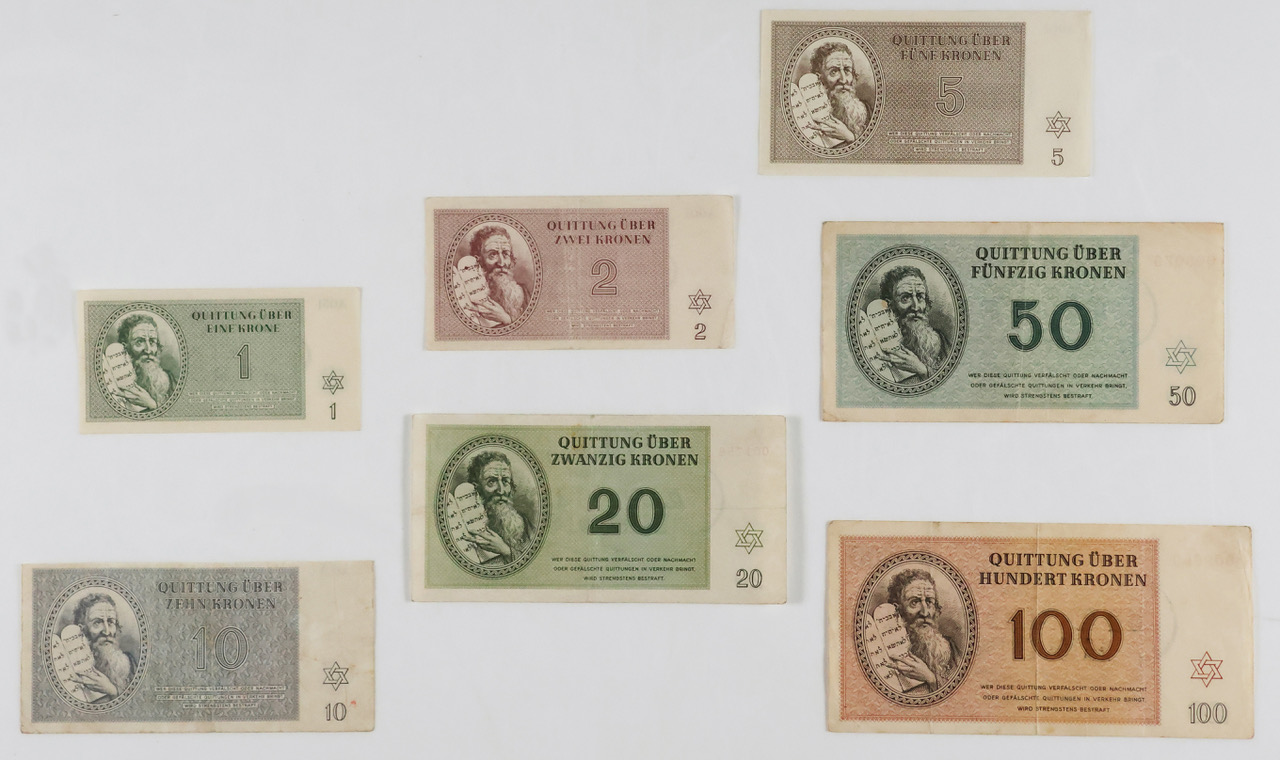
Theresienstadt: Der Alteste der Juden, 1943. Original documents. This complete seven-piece currency set from the notorious Theresienstadt camp sheds light on the elaborate sham by the Nazi propaganda machine to present Terezin as a "model camp."
Even though no normal trade and business activities were possible in concentration camps, it was not uncommon to see local notes and tokens. As soon as deportees arrived they had to exchange all their money, bonds and shares into “local currency.”
At the camp of Theresienstadt located North of Prague and in the old stronghold of Terezin, the notes were divided into the following seven denominations: 1, 2, 5, 10, 20, 50 and 100 Kronen - the Krone being the currency of Bohemia and Moravia. All those different values had the same design, but differed in size and color.*
The notes were designed in 1942 by Czech artist, poet and inmate Peter Kien** (who died in Auschwitz in 1944). The primary design was a vignette of Moses holding the Ten Commandments and it was approved in the first instance by Jacob Edelstein, the Chief of Theresienstadt’s Council of Elders. His original design of Moses’ portrait was approved by the Council of Jewish Elders and the camp commandant but not by Adolf Eichmann, head of the Gestapo Department for Jewish Affairs. He considered Moses too Aryan in appearance and ordered that he should be portrayed with a prominent hooked nose and curly hair. Eichmann also required that Moses’ hand obscure the commandment “Thou shalt not kill,” and that the denominations be changed from “Ghetto Kronen” to just “Kronen.”
The front of the notes has a vignette of Moses holding the tablets of the Ten Commandments at left. In the centre are the words “Quittung Über” (Receipt for), the denomination in words then the denomination in numerals and a warning against counterfeiting. At the lower right is the denomination in numerals and a six pointed Star of David. The back of the notes includes the same “Quittung über” followed by the denomination. The place and date at lower left and the title - the first Elder of the Jews in Theresienstadt - and signature of Jakob Edelstein are at lower right. At left is the denomination in figures and Star of David and upper left the serial number (20, 50, 100 kr) or plate letter and number (1, 2, 5, 10 kr).
The notes were dated 1st January 1943 but the first distribution was not made until May 12 1943.
Although a good mean to bolster the ruse of normality within Theresienstadt, the notes had no real economic value but could be used to pay certain taxes, amongst others those on packages entering the camps (above the taxes already paid by the sender). Camp shops were only shop windows and, ironically, those windows were mostly filled with objects seized from the Jews at their arrival in the ghettos.
Life in the ghetto had little in common with the note’s lavish design. Almost all inmates perished or were transported to Auschwitz. More than 140.000 Jews have been transported to Theresienstadt. At the time of its liberation on May 8, 1945 only a little more than 17,000 starving and terrorized inmates were found.
Offered by Eric Chaim Kline, booth C22.
A Streetcar Named Desire, Tennessee Williams
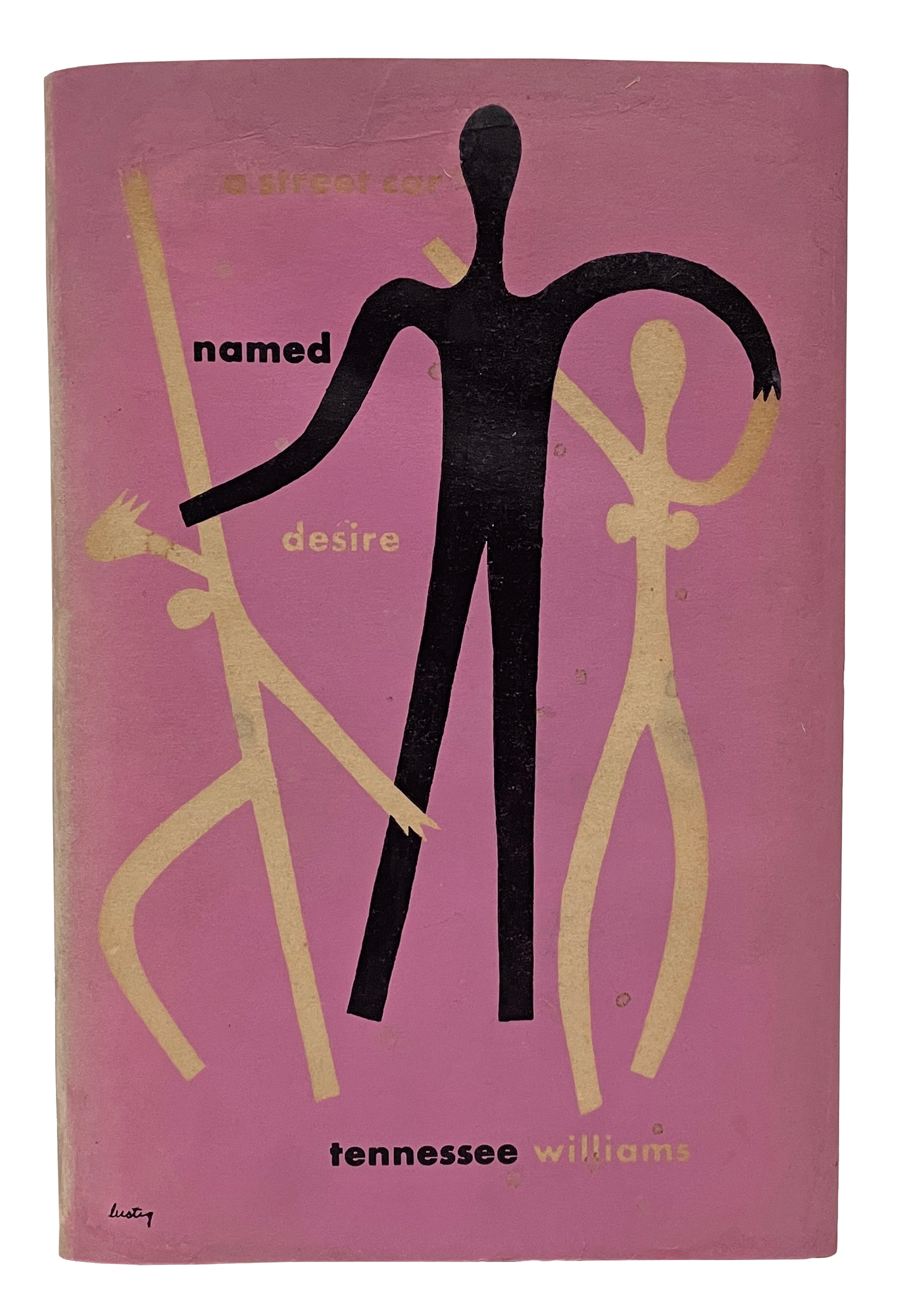
1947 first edition of Tennessee Williams's A Streetcar Named Desire, with the program from the very first stage performance on October 30, 1947, signed by everyone in the original cast, including Marlon Brando, Jessica Tandy, Kim Hunter, and Karl Malden. Includes ticket stubs from the premiere.
Offered by Honey & Wax Booksellers, booth B33.
Melville, Herman. Moby-Dick; or The Whale.
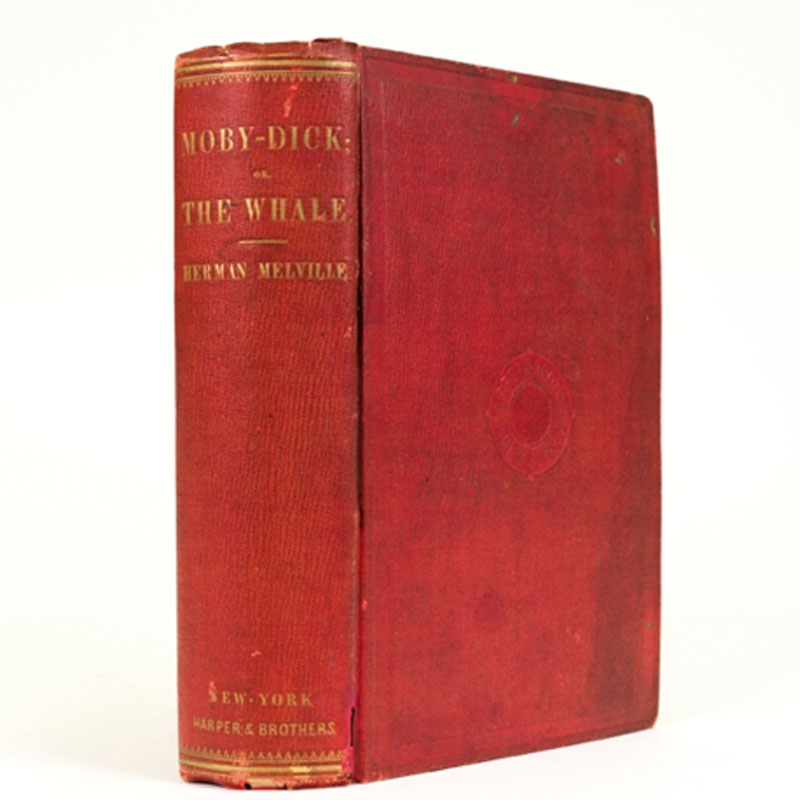
1851. New York. 8vo. . [iix], [x, numbered 9-10], [xi, numbered 11], xii-xxiii, [xxiv, blank], 1-635, [636, blank], six pages of publisher's advertisements at rear, preliminary and rear blanks. Original publisher's red "A" cloth (first binding), spine lettered in gilt with decorative gilt border at head and foot, blindstamped with publisher's circular device at center ("Harper Brothers New York") in blind-ruled frame; orange endpapers and double fly-leaves at front and back. Housed in a custom red cloth chemise and brown morocco-backed slipcase. Extremities a little worn, some consistent soiling to binding and top edge, front joint splitting at head, light browning to endpapers, minor repair to top corner of front free endpaper. Some foxing as usual, spine of slipcase a little faded: a very good copy.
First US edition of Melville's greatest work, in the first issue binding (BAL's "A" state, with the publisher's device on the covers and orange endpapers). The US edition was the first to bear the title Moby Dick and contains 35 passages and the epilogue by Richard Bentley, the British editor, omitted from the slightly earlier British edition. Red cloth is the rarest of the first issue binding colours, and more sought after that the more common blue examples.
Moby-Dick was originally issued in London earlier the same year, set from the New York sheets and titled The Whale. On publication, the novel was a "complete practical failure, misunderstood by the critics and ignored by the public; and in 1853 the Harpers' fire destroyed the plates of all [Melville's] books and most of the copies remaining in stock" (DAB, vol. 12, p. 523). Johnson notes that "tale of the sea" was "hailed from semi-obscurity... and acclaimed a masterpiece. The mystic quality of the pursuit differentiates this from the conventional adventure story" (Johnson, p. 57).
“Moby-Dick is the great conundrum-book. Is it a profound allegory, with the white whale the embodiment of moral evil, or merely the finest story of the sea ever written?... Within its pages can be found the sounds and scents, the very flavor, of the maritime life of our whaling ancestors” (Grolier American, p. 94).
Copies in first issue bindings appear in black, blue, grey, green, purple-brown, red, and slate-coloured cloth, without any priority. It was the custom of American publishers in the 1850s and 1860s to bind an edition in cloths of various colours, for the purpose of window display (Sadleir, p. 221).
Provenance: bookplate of one Benjamin L. Jacobs on front free pastedown.
Offered by HS Books, booth C15.
RARE COPIES OF THE WASTE LAND COMING TO THE NEW YORK BOOK FAIR
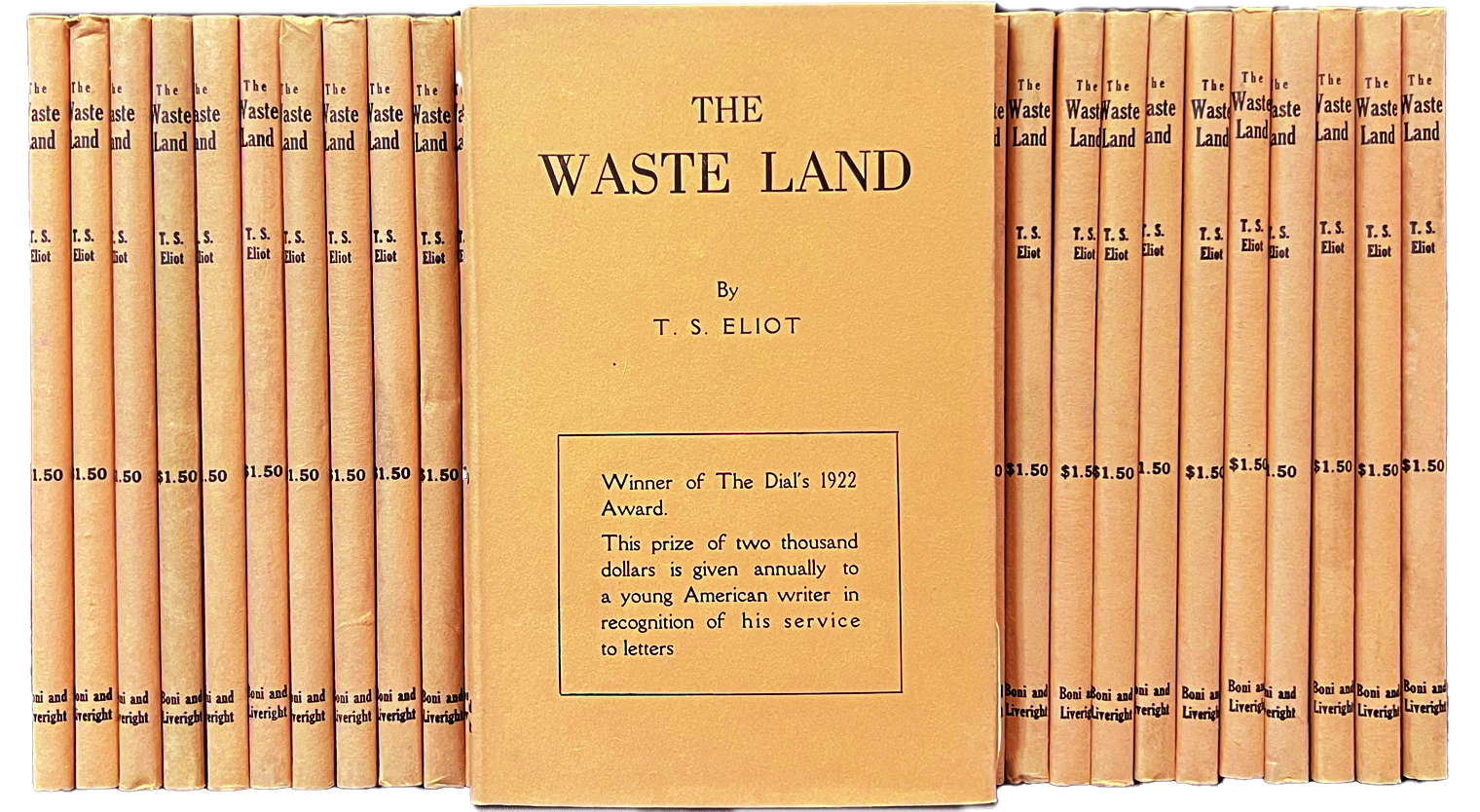
Not one, but multiple copies of The Waste Land, universally recognized as the most important poetical work of the 20th century, are coming to the ABAA New York International Antiquarian Book Fair (NYIABF). What’s even more significant is the provenance for these fine copies from the private collection of Scofield Thayer, the editor of The Dial magazine, the first to publish the work in the U.S.
A fine first edition in the original glassine and dust jacket, numbered 50, along with 34 fine copies of the second printing of the slim book of poetry are being offered by johnson rare books & archives, ABAA, in conjunction with Owl Creek Books. The two California firms acquired the volumes from relatives of Thayer who received them by descent.
“How does someone end up with so many perfect copies of this important book?” said Brad Johnson, co-owner of johnson rare books & archives. “The immediate answer is inheritance, a metal box, and a dark closet. The more complicated explanation is the unique relationship between T.S. Eliot, his friend and mentor, the poet Ezra Pound, and Scofield Thayer.”
Although the poem wasn’t quite complete, on January 20, 1922, Eliot offered The Waste Land to Thayer for publication in The Dial, which, thanks to Thayer’s financial support and creative input as editor and owner, had recently been transformed into an influential American outlet for modernist literature. Thayer immediately accepted it, sight unseen. However, it took months of negotiations and the support of Ezra Pound, before an agreement was reached. In the meantime, Eliot signed a contract with Boni & Liveright for its American publication in book form. Liveright allowed The Dial to publish the poem without notes, but in exchange, The Dial agreed to pay Eliot the regular rate for poetry of ten dollars per page, a total of $130; they announced Liveright would soon be publishing the poem with notes; they bestowed the annual Dial Award for service to American Letters on Eliot, along with the $2,000 prize money; and they purchased 350 of the 1,000 first edition copies Liveright published in 1922.
The Dial doubled its advertising budget around its publication of The Waste Land and offered a copy of the book of poetry with a one-year subscription for $5.50. “The Dial was prescient in its estimation of the book’s lasting influence. In their own advertising, they noted: ‘It is sure to become a collector’s rarity in a short time,’” said Nathan Gabbard, owner of Owl Creek Books.
The first edition is being offered for sale separate from the 34 second printings, which are being offered as a lot. “Together, the 34 second printings are a visual representation of the marketing influence The Dial put behind advancing this work,” Johnson said.
Offered by johnson rare books & archives, booth A35.
BIBLIA LATINA. [Strassburg, Heinrich Eggestein, not after 24 May 1466]. 2 vols. Royal folio (400 x 296 mm).
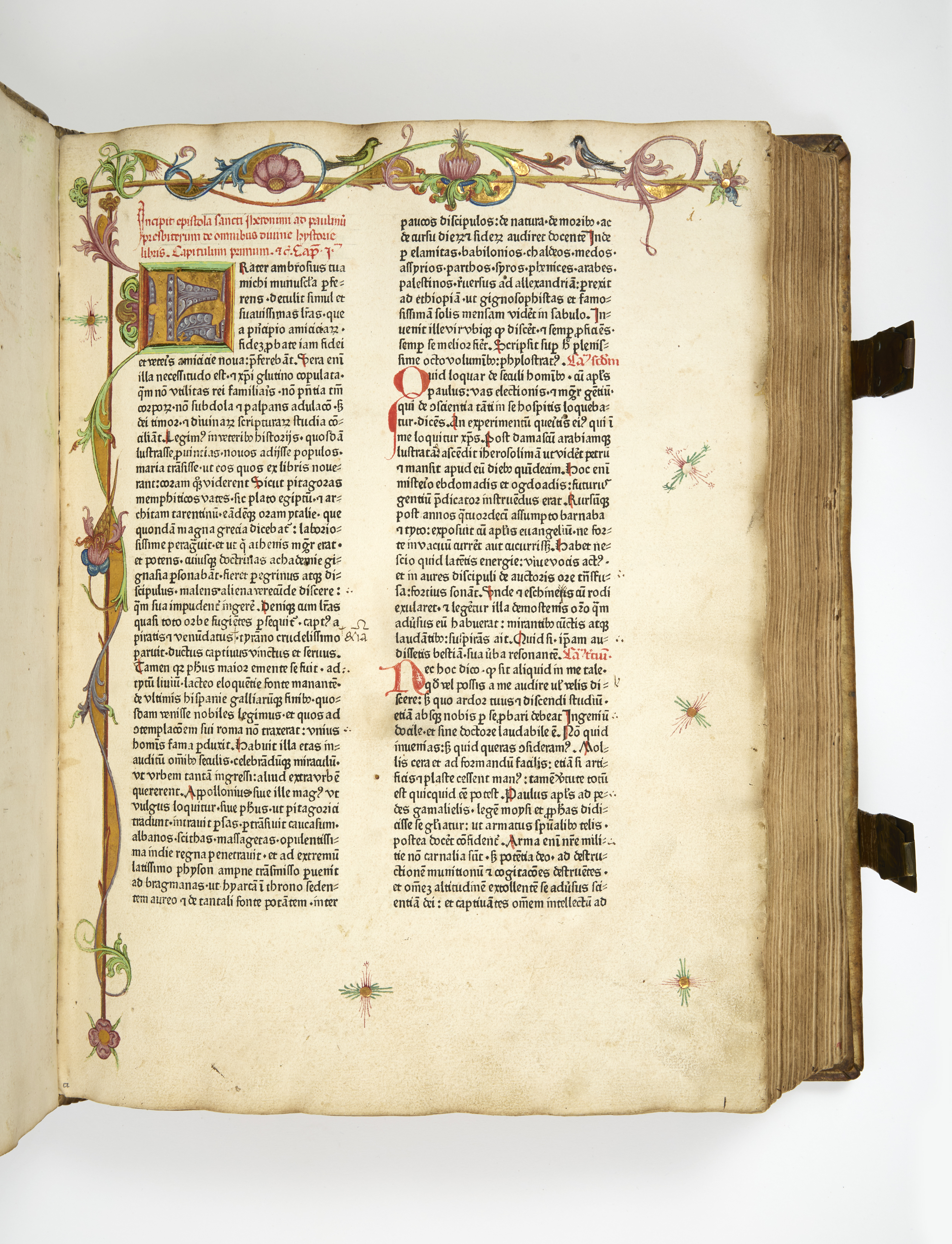
497 ff. including 4 blank, vol. I : 250 ll. (last blank) [a-k10 l-m12 n–x10 y-z12 A12] / vol. II : 247 ll. [B-G10 H12 I-L10 M12 N11 + stub, O-T10 V-X12 Y-Z10 aa10 bb8 ; I10 and bb7-8 blanks]. (Blank leaf I10 is unknown to Gesamtkatalog, but properly described by Goff and CIBN). 2 columns, 45 lines, type 1 : 126G. Rubricated copy, 3 ff. illuminated, 6-line illuminated initials on first leaves of each volume. Early quiring, later foliotation Contemporary Augsburg binding of stamped pigskin over wooden boards, four brass-and-leather clasps, pastedown of various manuscript leaves (some dating from the 11th c.), blank edges (Kyriss, Augsburg shop 89).
Fifth edition of the Latin Bible and the first published by Heinrich Eggestein. Second bible printed in Strassburg, with distinctive gotico-antiqua type, only used by Eggestein to print his Bibles and Auctoritates utriusque Testamenti. Eggestein introduced printing to Strassburg, a few years after J. Mentelin. He produced some 90 books or fly-sheets until 1483, including almanachs, bulls and law books.
Royal folio illuminated and rubricated in Augsburg. The 3 illuminated pages reveal high artistic quality. The illumination has been identified by Prof. König as probably the work of Johannes Franck, a Benedictine associated with the abbey of St. Ulrich and St. Afra. This is a fine example of Augsburg work mixing traditional burnished gold initials with bicolore frame becoming typical of Augsburg habits ca 1470. The copy presents refined calligraphy and rubrication. Some initial letters with grotesque heads skilfully traced. Not signed, the rubrication is close to Johann Bämler’s touch, documented in manuscripts and illuminated incunabula. We cannot rule out the collaboration of two artists. Floral and foliate extensions have kept fresh colours.
The edition is well represented in public libraries (a little over 40 copies), although numerous copies are imperfect. However, the bible is very rare on the market. The sales records mention only 3 copies, imperfect, sold in 1937 and 1947. Scheide’s copy was acquired privately in 1935 from book dealer Paul Gottschalk.
An impressive copy, attractively illuminated, finely rubricated, in its original pigskin binding, passed through the hands of distinguished collectors such as Henry Davis and Joost Ritman.
Light worming, central and corner pieces not present, one clasp renewed. The binder has not preserved the Tabula rubricatorum (this is also the case with Chantilly and Princeton copies).
Provenance : Augsburg, Abbey of St. Ulrich and St. Afra (inscription in vol. II). Henry Perkins (sale, 1873, lot 181). Sir Thomas Brooke (with bookplate). Rev. W. Ingham Brooke (with ms. ex-libris dated 1908 ; Sotheby's, 7 March 1913, lot 3). Charles S. Ascherson, 1913 (with bookplate, collection sold en bloc to Bernard Quaritch in 1945). Quaritch, cat. 637, 1946, no. 554. Paul Hirsch (note dated 1946 with inscription to his wife Olga). Lew D. Feldman (House of El Dieff), cat. Fortieth anniversary, 1974-1975, no. 2. Kraus, cat. 173, 1986, no. 12. Joost Ritman (ex-libris « Bibliotheca Philosophica Hermetica », acquisition in 1988 from Kraus).
Offered by Librairie Lardanchet, booth A4.
(Barnes, Djuna). Vintage Corona Model 3 Folding Typewriter: with a leaf of corrected typescript.
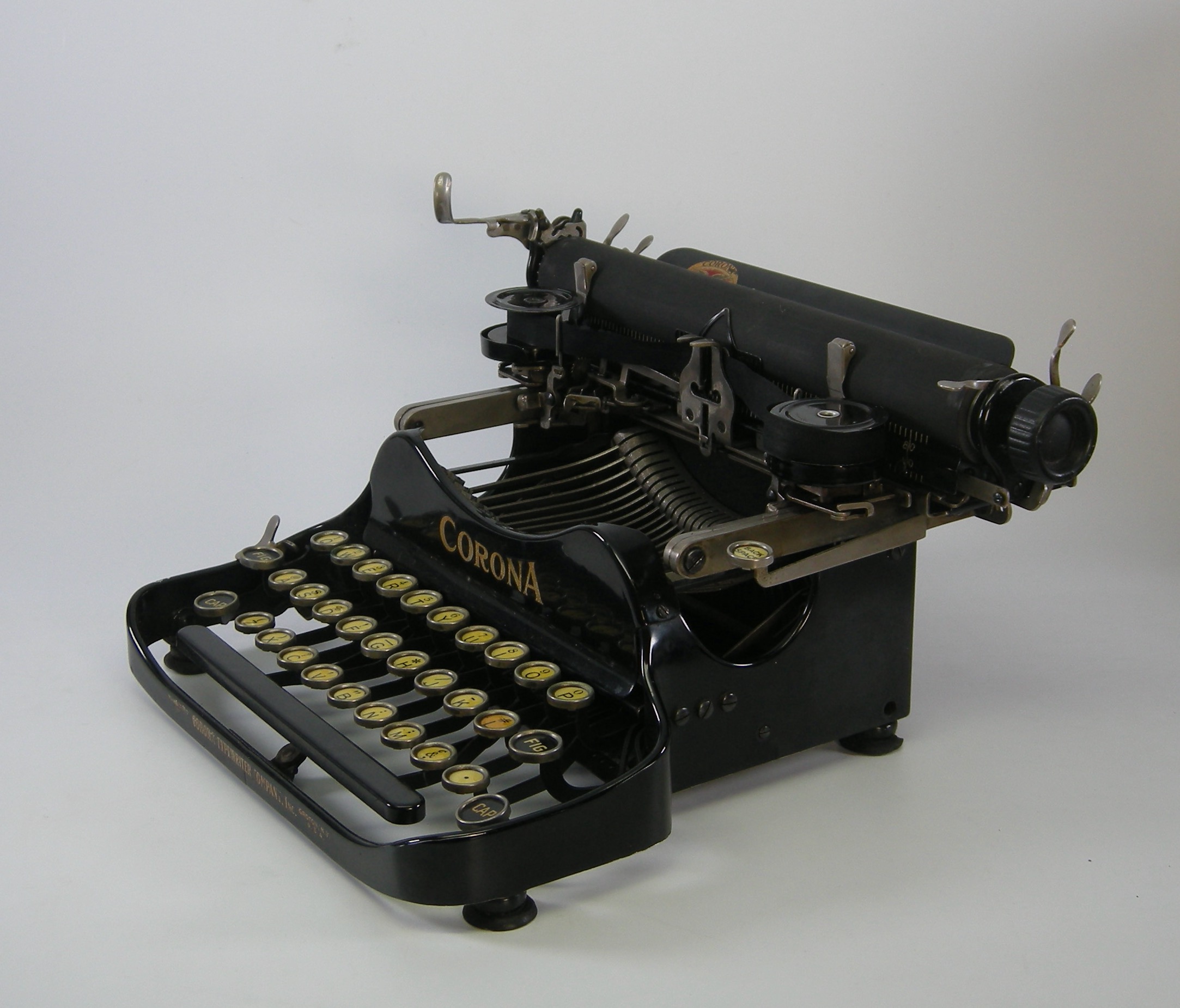
ca 1917-1925. Black-enameled folding typewriter in original branded case with leather handle; typescript page on a leaf of watermarked Waverley paper. Case broken at joints; typewriter in working order.
The model 3 was among Corona's most popular typewriters and was used by notable writers, such as Isak Dinesen, Ernest Hemingway, and Aldous Huxley; this one belonged to Djuna Barnes. We estimate that it was manufactured sometime between 1917 and 1923. It has the latest patent-renewal date of 1917 on the rear; in 1926 Corona merged with the L.C. Smith Co. to form Smith-Corona. Offered together with a page of corrected typescript from Barnes's short play "Biography of Julie Von Bartmann," written in Paris 1923-24 and indicating that she used this typewriter at that time. The play remained unpublished until 2020. This page is numbered "14" with the title typed at the upper margin. There are holograph corrections in two colors of ink and pencil in Barnes's hand amounting to about thirty words; other typed text has been crossed out either by hand or by overtyping with Xs. A comparison with the published text shows that the revisions made here were not incorporated into the book version. Both the typewriter and manuscript page were rescued from oblivion by one of the writer's closest friends during the last decade of her life who helped to clean out her apartment after her death in 1982.
Offered by Locus Solus Rare Books, booth A7.

